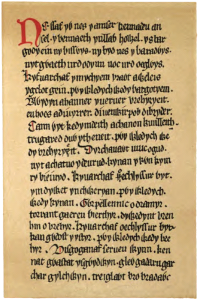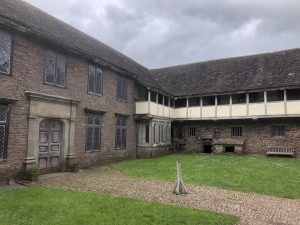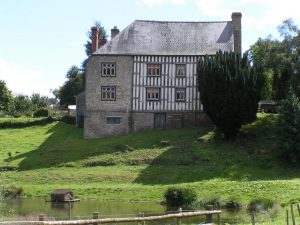When the bards rose to sing their verses at Tretower, Roger Vaughan’s noisy retainers would have fallen silent. Drinking and warmongering were not the only pursuits there; literature and song were appreciated too.
On 4 March 1464, at Dryslwyn, near Carmarthen, Roger was instrumental in the defeat of the Lancastrian uprising in south Wales. Amongst the vanquished rebels was Hopcyn ap Rhys ap Hopcyn, whose forfeited estates were duly assigned to Roger. Hopcyn came from a highly cultured family and is likely to have owned many fine books. Among them was a volume that is considered one of the most important of all Welsh manuscripts.
The Llyfr Coch Hergest, or Red Book of Hergest (Jesus College MS 111, now on deposit at the Bodleian), is a compendium of classic Welsh texts. A large and weighty tome, it was written shortly after 1382, on vellum, and bound in red leather. It contains geographical, medical and historical texts (including a Welsh translation of Geoffrey of Monmouth), collections of poetry, and all eleven tales of the Mabinogion corpus, for which it is the primary source.
One of the three scribes who worked on the Red Book, Hywel Fychan, is known to have been employed by Hopcyn ap Tomas of Ynysforgan, Swansea, who was a notable patron of the bards in south Wales and a well-known collector of manuscripts. In 1403, Hopcyn was even consulted by Owain Glyndŵr as a ‘Maister of Brut’, or interpreter of old bardic prophecies.
It was probably this Hopcyn who commissioned the Red Book. It contains five awdlau or odes in his honour and two other texts that are addressed to his son. Hopcyn ap Thomas was the grandfather of the defeated rebel, Hopcyn ap Rhys ap Hopcyn, hence its coming into the possession of the Vaughans at Tretower.(1)
In the years that followed, the contents of the Red Book were hungrily devoured by the itinerant bards who frequented Tretower. Among them was Lewis Glyn Cothi, who added a couple of odes of his own, honouring Sir Roger’s son, Sir Thomas, and his grandsons. Ironically, Lewis was a supporter of the Lancastrians (whose triumph he lived to witness), but this ‘did not prevent him from singing to patrons who supported the Yorkists, and few poets broadcast eulogy so widely over Wales as he did’.(2)
Even the Yorkists among them were Welshmen at heart. In his praise poem to Roger Vaughan’s half-brother, William Herbert, 1st Earl of Pembroke (1468), Guto’r Glyn (who eventually went blind, like Homer) urges him to rule fairly and favour the Welsh. His poem ends with the lines:
‘Make all one from the Conwy to the Neath.
If England and her dukes are angered,
Wales will come to your need.’(3)
An admiring bard, perhaps Lewis Glyn Cothi, must have taken the Red Book from Tretower to Hergest Court, at Kington in Herefordshire. Sir Roger Vaughan had perhaps made a gift of it to his elder brother, another Thomas, who was the lord of Hergest (called ‘Herast’ by Lewis, which is closer to the original Welsh, ‘deep glen’; otherwise pronounced ‘Hargest’, as Herbert was pronounced ‘Harbert’) and had made his seat there. Both the Red Book and the bardic tradition were preserved at Hergest for at least three generations.
A fortified medieval manor-house, contained within a moat, Hergest Court had been the property of the Clanvowe family, who completed the east wing in 1267. That structure is two storeys high and built of stone. The walls are three feet thick.
Thomas, however, had expanded Hergest into a court house that was at least as impressive as Tretower. Lewis, indeed, compares it to the Moorish palace at Alhambra, for it consisted of ‘eight strong buildings or fortresses’, each with its own ‘refectory and good stock of wine’. As Tretower also had accommodation for more than one household, the brothers must have striven to match each other in the splendour of their new homes. As at Tretower, too, the upper floor of Thomas’s north wing was fashionably timber-framed. The timbers there have been dendro-dated to 1452.(4)
In 1469, Thomas Vaughan, aged 69, once again marched out, with his kinsmen and retainers, in the Yorkist cause. He fought a brave fight at the Battle of Banbury, but was overwhelmed and beheaded. Lewis Glyn Cothi and Guto’r Glyn both wrote unctuous eulogies. Thomas’s widow, Ellen Gethin ‘the Terrible’, survived him, however, as did the bardic tradition at Hergest, under his son Watkin and his grandsons James and Roger.(5)
The already impressive library of the Vaughans was augmented by 362 volumes from the Cistercian Abbey near Neath, dissolved in 1539, which the last of the monks entrusted to their safe hands. By 1562, however, the Red Book, at least, had been sold or given away, for it was then in the possession of Sir Henry Sidney, President of the Council of Wales and the Marches, at Ludlow Castle. His son was Sir Philip Sidney, who may have leafed through it while on holiday from Shrewsbury.
Having passed through various hands, the Red Book was donated in 1701 to Jesus College, Oxford, the Welshmen’s college.(6) The original manuscript can now be viewed online, and translations of the Mabinogion (a collection of rattling good yarns) are readily available, not least in the shop at Tretower. As a mythology for Wales, the Red Book of Hergest surely inspired Tolkein’s ‘Red Book of Westmarch’. Also bound in a red cover, the work not of Welsh bards but of hobbits, this was the source of Bilbo and Frodo’s tales in his legendarium.(7)
Hergest Court Described
Hergest Court ‘stands like some bold veteran grey in arms, on the northern bank of the river Arrow, in a fertile vale or glen, and is a sight well calculated to rouse thoughts of by-gone times’.
The male line of the Vaughans of Hergest died out in 1706. The estate went to Frances, daughter of John, whose husband, William Gwyn Vaughan of Trebarried, was a distant cousin, descended from a bastard of Sir Roger of Tretower. Their granddaughter, Roach Vaughan, took the estate into the family of the Harleys, earls of Oxford. No longer of use to them, Hergest Court was abandoned in the mid-1700s. It was largely dismantled, what remained being reduced to ‘a common farm-house’.
For that reason, it has never been modernised. ‘Over the kitchen fire-place is a very large transom stone – and in various parts of the house are some fine specimens of old English wainscoting.’ The solar on the upper floor survives, with another huge fireplace, stone seating and heraldic stained-glass windows. There is an adjacent ‘ladies’ room’. But the whole upper floor is empty of life today. In 2018 it was described as ‘an attic full of old clutter’.
The extensive farmyard is still ‘ornamented by a few old arches in the Norman style’. The Vaughans were recusants (the adjacent stone stable or granary is their former chapel) and keen swimmers (a deep pool in the River Arrow is said to have been reserved for the ladies of the house). Owned by the Banks family since 1912, it is the most remote and romantic of houses, and its literary history is thrilling.(8)
Lady Hawkins’ School
Charles Vaughan of Hergest, son of the James mentioned above, served as M.P. for Radnorshire in 1553, and his daughter Margaret was a Lady of the Bedchamber to Queen Elizabeth. In 1591 she married the recently-widowed Sir John Hawkins. As a merchant and the captain of his own fleet of ships, Sir John had amassed a great fortune. He later served as Treasurer of the Navy and was the commander of one of the squadrons that defeated the Spanish Armada. He is infamous, however, as a promoter of the trade in African slaves.
 When Lady Hawkins died in 1619, she left £800 for the endowment of a ‘free school’ in her native Kington. Lady Hawkins’ School is now a ‘comprehensive’, occupying modern buildings at Kington, but her (rather forbidding) portrait hangs in the entrance hall and her marital arms on a lozenge, Hawkins impaled with Vaughan, are the badge of the school.
When Lady Hawkins died in 1619, she left £800 for the endowment of a ‘free school’ in her native Kington. Lady Hawkins’ School is now a ‘comprehensive’, occupying modern buildings at Kington, but her (rather forbidding) portrait hangs in the entrance hall and her marital arms on a lozenge, Hawkins impaled with Vaughan, are the badge of the school.
Lady Hawkins’ School now agonises about its connection, however tenuous, with the slave trade.(9) But Sir John was a ‘product of his age, which accepted slaving with an easy mind’. He was unashamed to adopt an enslaved man as his crest. Contemporaries were more shocked by Margaret’s tightfistedness, for she refused to ransom her stepson, Richard, from Spanish captivity, in which he languished for eight years.(10)
The continued existence of the school proves that good things may come from bad. Former pupils include the singer Ellie Goulding, who described it as ‘happy and supportive’,(11) and the actress Jessica Raine. The advice of John F. Kennedy is pertinent: ‘We will be just in our time. This is all we can do. We must be just today.’(12)
(1) Griffith Williams, ‘Hopcyn ap Thomas’ in Dictionary of Welsh Biography; TEI Header for Oxford Jesus College MS. 111 (The Red Book of Hergest), https://www.rhyddiaithganoloesol.caerdydd.ac.uk/en/tei-header.php?ms=Jesus111.
(2) Evan Jones, ‘Lewis Glyn Cothi’ in Dictionary of Welsh Biography.
(3) Ifor Williams, ‘Guto’r Glyn’ in Dictionary of Welsh Biography; https://parallel.cymru/poets/.
(4) D.W.H. Miles, The Tree-Ring Dating of Hergest Court, Centre for Archaeology Report 13, English Heritage, 2001.
(5) Evan Jones, ‘Vaughan Family of Hergest’ in Dictionary of Welsh Biography.
(6) The Welsh word ‘Llyfr’, incidentally, is a word borrowed directly from the Latin (liber = book) during the period of the Roman occupation. (https://welearnwelsh.com/words/15-welsh-words-french-latin/.
(7) See Mark T. Hooker, ‘The Feigned-manuscript Topos’, Tolkienian mathomium: a collection of articles on J. R. R. Tolkien and his legendarium, Llyfrawr, 2006, pp. 176–177.
(8) The History of Kington, by a Member of the Mechanic’s Institute of Kington (Kington, 1845), pp.216-24; Residents of Hergest Court, a Talk by Allan Lloyd’, and Karen Blake, ‘Hergest Court 7th June 2018’, Leintwardine History Society, https://leintwardinehs.wordpress.com/2018/04/11/residents-of-hergest-court-a-talk-by-allan-lloyd/ and https://leintwardinehs.wordpress.com/hergest-court-7th-june-2018/.
(9) Nic Dinsdale, Sir John Hawkins, Elizabethan Explorer and Privateer (Kington, 2003), and ‘A School with a Slaving Past’, https://www.bbc.co.uk/herefordandworcester/content/articles/2007/03/01/abolition_lady_hawkins_feature.shtml‘
(10) Basil Morgan, ‘Sir John Hawkins’ in Oxford Dictionary of National Biography.
(11) Hereford Times, 14 May 2019.
(12) Quoted in A.C. Cairns, Citizens Plus (Vancouver, 2000), p.52.




